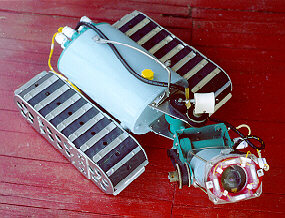Deployment:
A BROV can be deployed from a boat, from shore or from a dock or other structure. The umbilical cable is buoyant so it floats up in the water column in an arc which keeps it from snagging on things on the bottom. The best form of deployment is from an air conditioned boat with a dimly lit interior with a proper array of large size computer and video monitors (my future research vessel). Deployment from an open boat is possible but presents problems. The biggest problem is that you cannot view a TV monitor in open sunlight. The only option is to use some kind of a hood over the monitor. This is not much fun for other members of the party as only one person will be able to view the monitor. The obvious cure for this problem is to do your exploration at night. Another option is to use a boat that has a cabin which can be darkened so many people can view the monitor. Of coarse, you will tape your exploration to view later under better conditions.
The BROV only weighs about eight pounds submerged but weighs about 40 in air. The BROV must be carried by the handle on the main hull until it is submerged and then it is lowered to the bottom by use of the umbilical. To retrieve, it is pulled to the surface with the umbilical and lifted out of the water by the handle. The big problem if operating from shore or from a dock is in the case of a propulsion failure or a snagging event and you can't get it back by driving it. A snagging event is most likely to occur from entanglement with monofilament fishing line or other debris. If the BROV needs to be dragged with the umbilical to shore the BROV will be dragged onto its side and make it a pretty good anchor. The BROV or umbilical might be damaged.
Sediment can be stirred up by the tracks blocking visibility. This is one reason the nose of the camera is about 12 inches ahead of the tracks. Most places have some sort of prevailing current whether it be tidal action or river current. You can avoid obscured visibility by operating into the current so the sediment is carried away from the camera.
Deployment of a BROV is not trivial. The following items are required to be transported to the boat and in most cases fastened down in some way and interconnected and wired up.
1. the BROV
2. umbilical cable
3. topside junction box
4. three 12 volt batteries
5. computer
6. television or video monitor
7. video cassette recorder
8. associated interconnect cables
9. inverter (converts 12 VDC to 120 VAC)
The BROV operates on 36 volts DC. I use three batteries of the type used for lawnmowers in series. Static current draw of the BROV with the lights on is about 3.5 amps. Current draw while moving is about 4.5 amps. Endurance would depend on the rating of the batteries but should be at least 5 to hours for small batteries. My VCR and TV run on 120 VAC so I need to run an inverter from one of the batteries to power them. The inverter could be operated from the electrical system of the boat.
.
